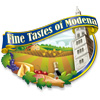Salumi
Zampone & Cotechino
There are foods that end up identifying a folk or a city, and with this in mind we can reconstruct important aspects of a population's history. The Zampone (pig's feet) is a perfect example. Its legend is skillfully interwoven with history. It seems that its birth dates back to 1511, when the papal troops of Pope Julius II della Rovere besieged Mirandola which is located near Modena. Mirandola, home of the famous Count Giovanni Pico della Mirandola, was also a faithful ally of France. Towards the end of the siege, the people of Mirandola were on the brink of starvation. The only foodstuffs remaining to them were pigs. Leaving them unslaughtered would mean giving them to the enemy.
One of the chefs to Count Pico suggested that the meat be grounded and then stuff the leaner meat into the skin of the pig's foreleg. This method ensured that the meat would be conserved until eaten at a later time. And so it was done. Unfortunately shortly there after on January 20, 1511, the people of Mirandola were forced to surrender and the first Zampone was eaten by the Papal Troops.
Zampone is an excellent example how all of the best parts of the pig are used. The meat is refrigerated between 0 ° to 4 ° Celsius (32 ° to 39 ° Fahrenheit). Next everything is ground and mixed with various spices, flavorings (this remains a secret of all Zampone makers), salt and nitrite: a natural additive used for preserving sausage and salami. The fresh, lean pork and tender rind mixture is then stuffed in a casing made from the pig's foreleg. The Zampone is then simmered at about 50 °C (122 °F) for twenty-four hours. The same procedure applies to a precooked product. The only difference is that it is cooked at a higher temperature of 120 °C (248 °F) for three hours. A precooked, vacuum packed Zampone is much easier and quicker to prepare.

Gioacchino Rossini, the famous composer of "The Barber of Seville" was fond of this delicious mixture of meat which he eventually defined the Zampone as a "brillante maialesco", meaning that it was as precious as a diamond.
In Modena, it is tradition to eat Zampone on New Year's Eve with a side dish of lentils or kidney bean stew, in addition to mashed potatoes or spinach mixed with butter and Parmigiano Reggiano.
The Cotechino is universally recognized as the father of the Zampone. Its name derives from "cotica" which means the pig's rind. The idea of stuffing the meat of the pig in a small casing made from the pig's intestines was a very antique and effective method for preservation. More recently a natural pork casing replaced the intestines. It's the casing which differentiates the Cotechino from the Zampone. The Cotechino uses a natural pork casing while the pig's foreleg is used for the Zampone. As previously mentioned, Cotechino came many years before the Zampone, originally being sausage for poor people. It was usually eaten with stew or vegetable soup. It was handmade by "salsicciari Modenese" Modena's sausage makers.
The first reference of the Cortechino was in 1745 recorded on a "calmiere": a document indicating its price. The first Cortechino recipe appeared the following year.
It wasn't until the beginning of the last century when the Cortechino reached its culinary fame. In 1910 Pellegrino Artusi titled recipe number 322, "Wrapped Cortechino" in his famous cookbook La scienza in cucina e l'arte di mangiar bene (The science of cooking and the art of eating well).

Cortechino has an elongated shape and is normally placed in warm water to soften its casing. It is cooked in boiling, unsalted water and wrapped in a cloth to prevent it from splitting.
Like the Zampone, a commercialized, precooked version of the Cortechino is available in a vacuumed packed bag, suitable for placing in boiled water for reheating. Cortechino is also a typical dish during the Christmas holiday and New Year's Eve, with a side dish of lentils or kidney bean stew, in addition to mashed potatoes or spinach mixed with butter and Parmigiano Reggiano.
 Fine Tastes of Modena
Fine Tastes of Modena
follow us on: